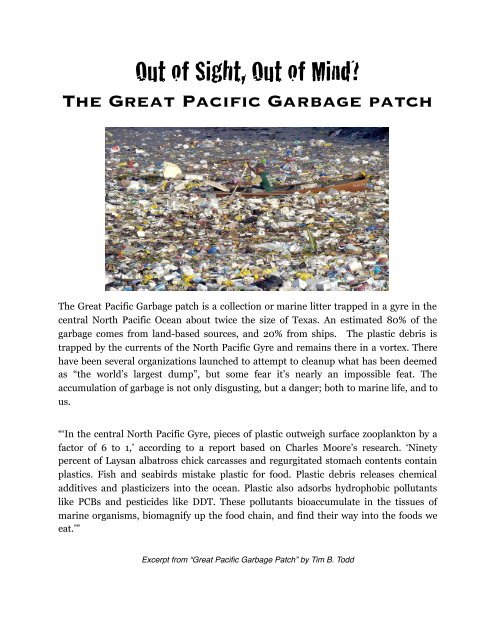The Skriker Actor Packet
The Skriker Actor Packet
The Skriker Actor Packet
Create successful ePaper yourself
Turn your PDF publications into a flip-book with our unique Google optimized e-Paper software.
Out of Sight, Out of Mind?<br />
<strong>The</strong> Great Pacific Garbage patch<br />
<strong>The</strong> Great Pacific Garbage patch is a collection or marine litter trapped in a gyre in the<br />
central North Pacific Ocean about twice the size of Texas. An estimated 80% of the<br />
garbage comes from land-based sources, and 20% from ships. <strong>The</strong> plastic debris is<br />
trapped by the currents of the North Pacific Gyre and remains there in a vortex. <strong>The</strong>re<br />
have been several organizations launched to attempt to cleanup what has been deemed<br />
as “the world’s largest dump”, but some fear it’s nearly an impossible feat. <strong>The</strong><br />
accumulation of garbage is not only disgusting, but a danger; both to marine life, and to<br />
us.<br />
“‘In the central North Pacific Gyre, pieces of plastic outweigh surface zooplankton by a<br />
factor of 6 to 1,’ according to a report based on Charles Moore’s research. ‘Ninety<br />
percent of Laysan albatross chick carcasses and regurgitated stomach contents contain<br />
plastics. Fish and seabirds mistake plastic for food. Plastic debris releases chemical<br />
additives and plasticizers into the ocean. Plastic also adsorbs hydrophobic pollutants<br />
like PCBs and pesticides like DDT. <strong>The</strong>se pollutants bioaccumulate in the tissues of<br />
marine organisms, biomagnify up the food chain, and find their way into the foods we<br />
eat.’”<br />
Excerpt from “Great Pacific Garbage Patch” by Tim B. Todd



